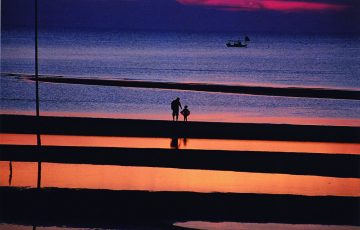 Those living in Japan who love nature, hiking, and natural beauty simply must find the time to visit Yakushima. Yakushima is a small island in Kagoshima prefecture famous for its ancient Yakusugi forest and UNESCO World Heritage Site status. The forests of Yakushima inspired Miyazaki Hayao’s masterpiece Mononoke Hime (“Princess Mononoke”) and are absolutely marvelous. The deep greens and thick roots that snake across the ground, the moss covered rocks, the sparkling streams, and the ocean-side hot springs take traveler’s minds away from the stress of big city life in Japan. Yakushima is incredibly photogenic, and its nature is so pristine that you can drink straight from the streams – truly a destination worth visiting.
Those living in Japan who love nature, hiking, and natural beauty simply must find the time to visit Yakushima. Yakushima is a small island in Kagoshima prefecture famous for its ancient Yakusugi forest and UNESCO World Heritage Site status. The forests of Yakushima inspired Miyazaki Hayao’s masterpiece Mononoke Hime (“Princess Mononoke”) and are absolutely marvelous. The deep greens and thick roots that snake across the ground, the moss covered rocks, the sparkling streams, and the ocean-side hot springs take traveler’s minds away from the stress of big city life in Japan. Yakushima is incredibly photogenic, and its nature is so pristine that you can drink straight from the streams – truly a destination worth visiting.
Despite Yakushima’s wonders it receives relatively few visitors each year. A modest 300,000 tourists visit Yakushima each year (compare to Kyoto’s estimated 50 million), most likely due to its remote location. Visitors must first fly to Kagoshima and then take a boat over to the main island. Once arriving most visitors rent a car because public transportation is insufficient to get around effectively. At least three days are necessary to experience the sights of Yakushima, so a successful trip would be difficult to pull off without taking advantage of one of Japan’s many three-day weekends.
My personal visit to Yakushima was a quick three-day and two-night stay. Our main objective was to hike to the top of the 1,935-meter high Miyanoura-dake, the islands highest point. The hike usually takes about five hours from the starting point of Yodogawa Tozanguchi.
We arrived on a Friday, made the quick hike to Yodogawa Tozanguchi, and stayed the night in Yodogawa Koya cabin before setting off at six in the morning in an attempt to reach the top of Miyanoura-dake by noon the next day.
The hiking route to Miyanoura-dake is well traveled, but visitors still need to rough it a bit. Yodogawa Koya, the first public cabin available after entering at Yodogawa Tozanguchi, has no showers, no heating, no lights, no bedding, not even any running water, and visitors must carry their own trash until they return to the city. Travelers are advised to bring first aid equipment, flashlights, toiletries, a sleeping bag, and rain ponchos among other things. The rain ponchos are a must, it is jokingly said to rain 35 days a month on Yakushima. For about one hour we were the only group of travelers at the cabin.
 We tossed our sleeping bags onto the wooden bunks and headed out into the moonlight to try and get dinner started. Before long a solitary male Japanese hiker came along, and before we knew it we were sharing the local Shochu known as Mitake and eating pasta over a burner. The stars that night were incredible. It sounds cliché, but on Yakushima you will be able to see more stars than you knew existed.
We tossed our sleeping bags onto the wooden bunks and headed out into the moonlight to try and get dinner started. Before long a solitary male Japanese hiker came along, and before we knew it we were sharing the local Shochu known as Mitake and eating pasta over a burner. The stars that night were incredible. It sounds cliché, but on Yakushima you will be able to see more stars than you knew existed.
When we woke up the next morning our new friend had already left. We packed up our things, ate some breakfast bars and set off. The trek to Miyanoura-dake is not an arduous mountain climb, but it is just long enough to make you wonder whether you’ll ever make it to the top. The scenery along the way is diverse and beautiful. You’ll go across streams, use ropes to climb up steep rocky inclines, encounter Yakushika if you’re lucky (the deer native to Yakushima island), and discover breathtaking views of sprawling green fields and large stone boulders strewn about.
 We arrived at the peak just before lunch and sat down to enjoy the meals that we had packed. We were quickly joined by a large group of elderly Japanese women decked out in their fancy hiking gear. Before long we were all chatting, posing for pictures, and trading lunchbox items. After finishing we packed up our gear and started the hike back.
We arrived at the peak just before lunch and sat down to enjoy the meals that we had packed. We were quickly joined by a large group of elderly Japanese women decked out in their fancy hiking gear. Before long we were all chatting, posing for pictures, and trading lunchbox items. After finishing we packed up our gear and started the hike back.
The hike down always feels faster than the way up, and that night we stayed a local pension and ended our second day on Yakushima.
The third day we spent driving around to visit Shiratani Unsuikyo, the area specifically marked as the “Princess Mononoke Forest,” and enjoyed a hot springs located right on the ocean.
There are many other things to see, do, and eat on Yakushima, but our time was limited. Yakushima is a truly wonderful travel destination and I hope that many people get to enjoy it for generations to come.
Story by Harvey Beasley
From J SELECT Magazine, November 2009












-360x230.jpg)


Recent Comments